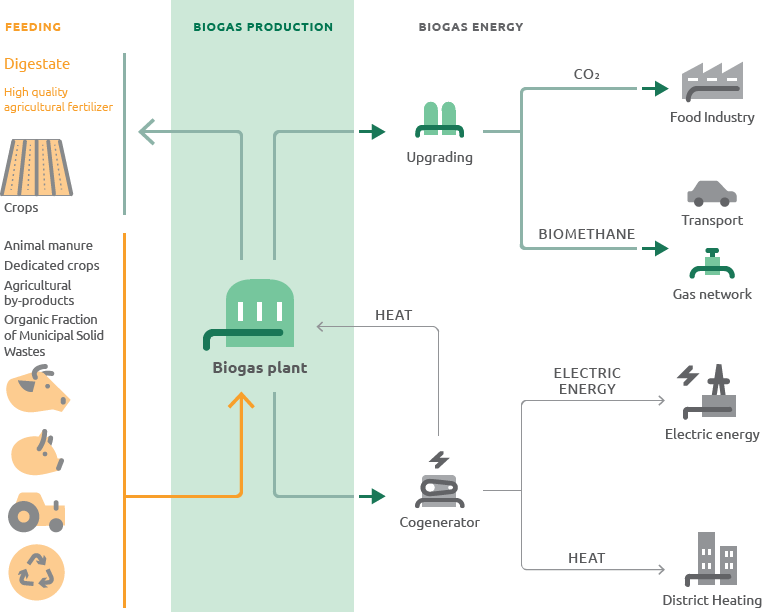The circularity of biomethane
Biomethane is a renewable, flexible, efficient and programmable source, can be transported in existing transportation and storage infrastructures, and integrates perfectly and in a totally complementary way with other renewable sources such as solar and wind power.
It is obtained, in dedicated facilities, from the anaerobic digestion of both agricultural sub-products (dedicated crops, agricultural sub-products and waste and animal waste), and agro-industrial sub-products (production waste from the food chain) and organic fraction of municipal solid waste (FORSU) through a biogas purification process.
Biomethane can already be injected into the existing infrastructure network and used in all sectors in which gas is employed to produce heat, electricity, or directly as a fuel in motor vehicles. Precisely as it is a renewable energy, on 2 March 2018, the Italian government issued a Ministerial Decree that incentivises the use of biomethane as a fuel for motor transport.
The biomethane production cycle

The biomethane has several benefits:
- It is the perfect example of a circular economy: both in agriculture, in the agro-industrial field, relating to the management of organic fraction of municipal solid waste (FORSU), the biomethane is produced from production waste and sub-products which once the anaerobic digestion process is completed are used as totally natural fertiliser capable of restoring the organic and nutrient substances needed from the perspective of a circular economy to the land;
- It is an efficient, flexible and programmable energy source: the presence of infrastructures like gas transportation and storage networks ensure that, unlike other renewable energies, once injected into the Snam network, the consumption of biomethane can be modulated according to requirements without additional investments;
- It is totally renewable and sustainable: biomethane, in spite of being a gas, is actually considered a neutral source from the perspective of greenhouse gas emissions and is totally renewable because its production takes place through the transformation of waste and organic material that would produce greenhouse gas emissions in any case. For biomethane from agricultural sources, it is recognised that carbon dioxide emissions produced during combustion are equal to the quantity of carbon dioxide absorbed by crops when they are growing, making the process neutral from the point of view of emissions. The process can go from “neutral” to “negative” if the carbon dioxide produced and separated during the biogas purification stage is employed in industrial and/or food uses. In addition, the production of biomethane is not competitive to the production of food and incentivising the use of particular “second harvest” energy cultures makes it possible to maintain an agricultural balance in the existing economy;
- It creates value for local communities: biomethane case be the source of a new local economy, creating jobs, increasing tax revenues for local communities, responding to the need to dispose of production waste and the organic fraction of municipal solid waste and, through special cultivation techniques, it combats the effects of desertification preserving and, sometimes, replenishing specific nutrients in the soil;
- It minimises the costs of decarbonisation: not requiring new investments in infrastructures and helping to exploit waste and sub-products, biomethane becomes a vital source for on focusing National and European objectives in terms of decarbonisation. A recent Ecofys study, promoted by the Gas for Climate association, which Snam is a part of, estimated that using renewable gas could lead to an overall saving in Europe of around €140 billion per year by 2050, compared with a scenario that doesn’t involve the use of biomethane.
Biomethane is therefore an energy resource that is ready to meet European and global objectives for reducing emissions exploiting existing gas networks and promoting an economic model based on the sustainability and circularity of the use of resources, with consequent positive effects on the agri-food industry.
The Enersi project
In 2018 Snam launched an innovative project relating to the recovery of organic fraction of municipal solid waste. Through the subsidiary Snam4Mobility, for a price of around €2 million it acquired 100% of Enersi Sicilia Srl, the company that owns the licence authorisation for the development of a biomethane and compost production infrastructure in the province of Caltanissetta. The biomethane produced will be injected into the network as a source of renewable energy, while the compost will be used as a natural fertiliser in place of chemical fertiliser.
The works, which began in December 2018 and continued throughout 2019, will be concluded by the middle of 2020 with the introduction of biomethane into the national network.
The plant will be capable of recovering 36 thousand tonnes per year of FORSU corresponding to around 3.2 million cubic metres of biomethane, equal to 30 GWh of energy produced each year.
The main advantages for the territory from this project are:
- New jobs and skills;
- Economic return for local businesses that will be involved in the construction phase and in supporting and supplying the new plant;
- Cost Saving for the citizenship in the transportation of waste outside of the province and a consequent reduction in emissions.